Contents
If the common goldenrod grows on the site, it is impossible not to notice it – it attracts attention with its bright color and original aroma. The plant is used not only as an element of landscape design, but also as a medicinal raw material and honey plant. Long flowering, rapid growth and unpretentiousness in care are the reasons for the popularity of the common goldenrod, which has many species and varieties.
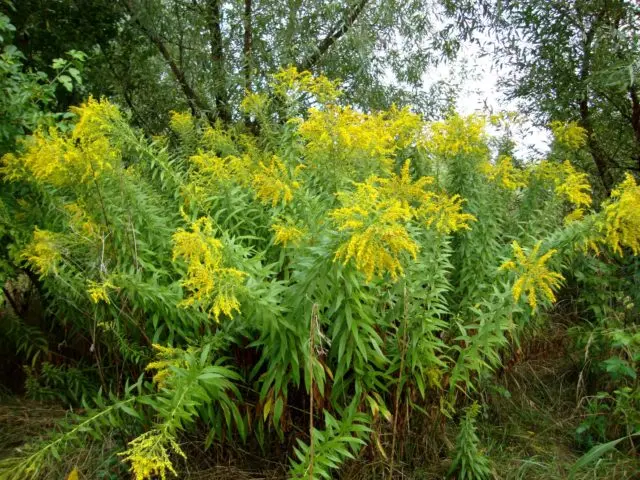
Goldenrod blooms from May to September
Detailed description of goldenrod
Goldenrod, or solidago, is a perennial herbaceous plant. Its stems are erect, from 30 cm to 2 m high. The leaves are elliptical in shape, slightly pointed, the arrangement is regular. The lower leaf plates form a winged petiole, the middle and upper ones are narrower, sessile. All parts of the plant have a slight pubescence. The rhizome is short, strong, woody.
Small bright yellow flower baskets are collected in paniculate inflorescences. Extreme (pistil) blossom before middle (bisexual). After pollination, fruits are formed on the plant – brownish achenes with a small tuft.
How and where does goldenrod grow
Since goldenrod is undemanding to soil, light, easily tolerates drought and severe frosts, it is widely distributed in Siberia, the European part of the Federation, the North Caucasus, the Far East, Scandinavia, the Mediterranean and North America. It can be found on forest edges, meadows, clearings and along roads. Perennial grows best on light, sandy, well-fertilized, breathable soils, with regular watering.
What does goldenrod smell like?
The aroma emitted by solidago is explained by its chemical composition, which includes essential oils (up to 1,4%), aromatic acids. From the plant during the flowering period comes a pleasant, pungent herbaceous smell with notes of pine needles and camphor.
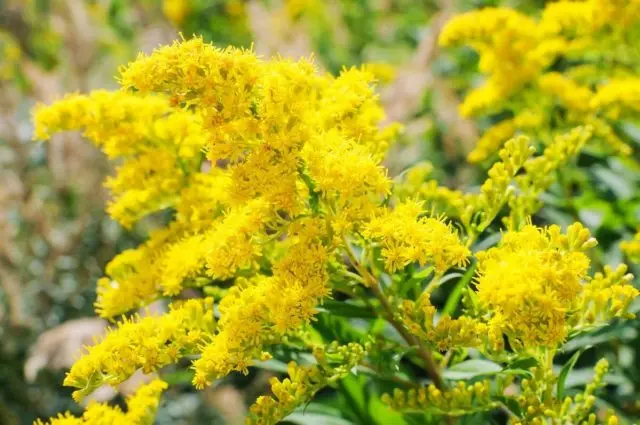
Goldenrod seeds can be dispersed over long distances
The difference between ambrosia and goldenrod
Very often, goldenrod is confused with ragweed, which belongs to quarantine weeds that can clog crops, perennial and annual grasses.
To distinguish it from ambrosia, you should pay attention to a number of features:
- ambrosia foliage resembles wormwood;
- its stem is branching, rectangular, with a visible furrow;
- the leaves are dark above, gray-green below;
- pubescence on the plant is dense, bristly;
- the inflorescence is spike-shaped.
Goldenrod as a honey plant
Solidago refers to honey plants. Its pollen and nectar attract bees during the flowering period, which lasts more than two months. Nectar is released all daylight hours, so the plant is often grown when the flowering of the main natural honey plants has ended.
Goldenrod honey productivity
One hectare of solidago plantings yields up to 150 kg of honey, which, when fresh, has a strong aroma and excessive astringency, and later acquires a soft and pleasant taste. Thick yellow or reddish honey is used in folk medicine to treat urinary tract pathologies and skin diseases.
Its crystallization passes very quickly – a month and a half after pumping out. Although, as a honey plant, goldenrod has an average honey productivity, it is suitable for wintering bees and allows you not to carry out additional feeding.
Types and varieties of goldenrod
The variety of goldenrods includes up to 100 plant species. Among them are tall, dwarf, with different periods of flowering and distribution area.
Canadian
Canadian goldenrod is widely distributed in North America and Eurasia. Its stems are straight, powerful, reaching a height of one and a half meters, richly covered with dark green leaves with jagged edges. Narrow racemose inflorescences consist of small lemon-colored baskets.

The roots of the Canadian goldenrod produce substances that inhibit the development of other plants.
Canadian goldenrod is used as an ornamental plant, which often runs wild and begins to capture more and more new territories. Perennial winter-hardy, able to spread quickly even on poor soils, does not require frequent watering.
Supreme
The highest goldenrod lives up to its name – its shoots reach 2 m in height, forming real thickets. The stems are not strongly branched, slightly pubescent. The location of dense emerald foliage on the shoots is alternate, their shape is lanceolate, the edges are serrated. The plant has bright yellow inflorescences in the form of panicles, the length of which sometimes reaches 35 cm. Perennial baskets bloom at the end of August, flowering lasts a month and a half.
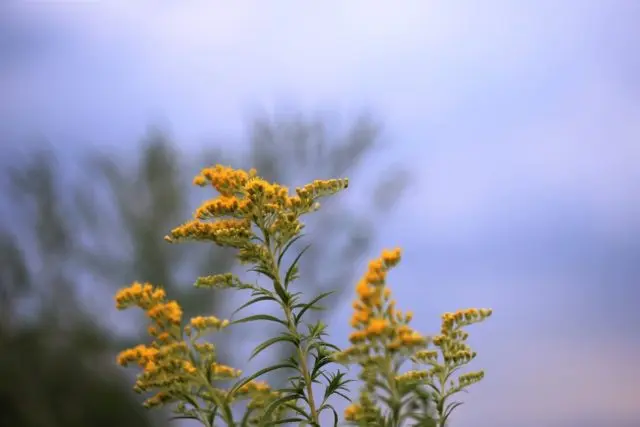
Homeland of the highest goldenrod – North America
Goldsmith Kutler
The species is dwarf, its height is 25 cm. The leaves are long, oval, rough in texture, with notches along the edges. The perennial stem is rarely leafy. Inflorescences are short, in the form of corymbs or brushes of amber color.
Goldenrod “Kutler” (Solidago cutlieri) is often used in landscape design for planting on lawns, borders and rockeries. Flowering begins at the end of August and ends with the first frost.

On the plot, the Kutlera variety goes well with cereals, larkspur and wrestlers
Goldenrod hybrid
It is from this species that the main hybrid ornamental varieties originate. They are distinguished by beautiful foliage and small bush sizes. Gardeners are attracted by the appearance and long flowering of hybrids. For their plots, they most often choose several varieties.
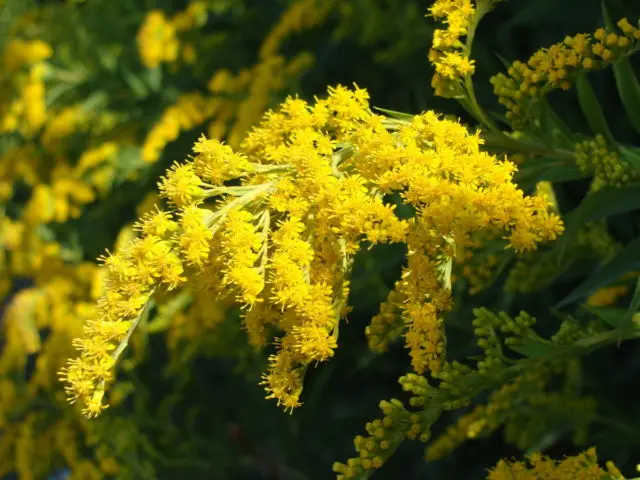
Solidago is the basis for the creation of medicinal teas, decoctions, ointments and oils
perkeo
Variety “Perkeo” (Perkeo) refers to the early. The cone-shaped bush has a height of up to 60 cm. Its pistachio shoots are strong, but look elegant. Foliage of emerald color densely covers the entire plant. The shape of the leaf plates is narrowed, the length is about 7 cm. The yellow decorative inflorescences in the form of brushes are 17 cm long and 20 cm wide. Flowering continues for a month and a half, starting in July.
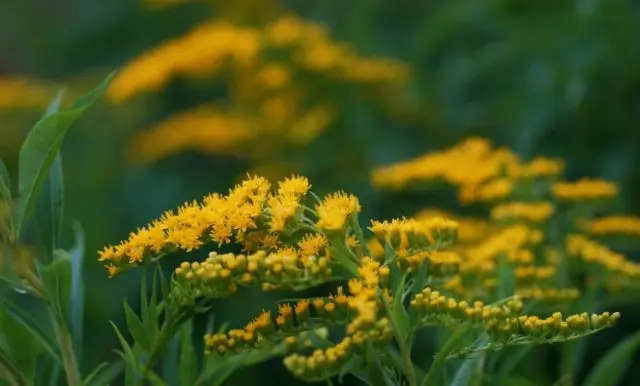
“Perkeo” – powdery mildew resistant variety
Golden Dwof
The hybrid variety “Golden Dwarf” (Golden Dwarf) has a height below 60 cm. Beautiful inflorescences of a shade of saffron 16 cm long appear on the perennial in August. Goldenrod ‘Golden Dwof’ can be grown in full sun or partial shade and prefers heavy clay soils that retain moisture well. Most often, flower growers have bushes in the form of separate plantings or as a background for other plants.
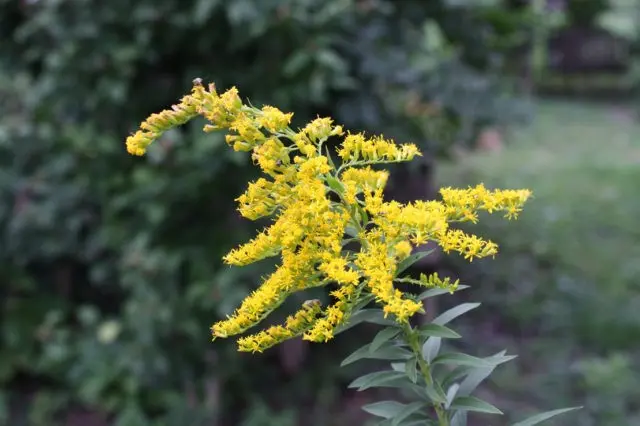
“Golden Dwof” looks spectacular in the cut
Dzintra
The variety of hybrid goldenrod “Dzintra” (Dzintra) was bred in the Baltic States, where it has found wide distribution. The bush has the shape of a column 60 cm high, dense structure, thick shoots, a large amount of bright green shiny foliage. Yellow inflorescences in the form of umbrellas appear in the second half of July and remain in a decorative state until September. Application in landscape design and floristry is universal.

After flowering, the above-ground shoots of “Dzintra” are cut
Goldjangle
Variety “Goldjunge” (Goldjunge) differs from others in its strong aroma and bush height up to 120 cm. Its branches are strong, the leaves are gray, narrow, long, with smooth edges. Inflorescences paniculate, golden yellow, up to 40 cm long, consist of small baskets. Judging by the description of the plant and its photo, the branches of the goldenrod look elegant, deviate beautifully from the bush. Flowering begins at the end of summer and continues until the beginning of winter.
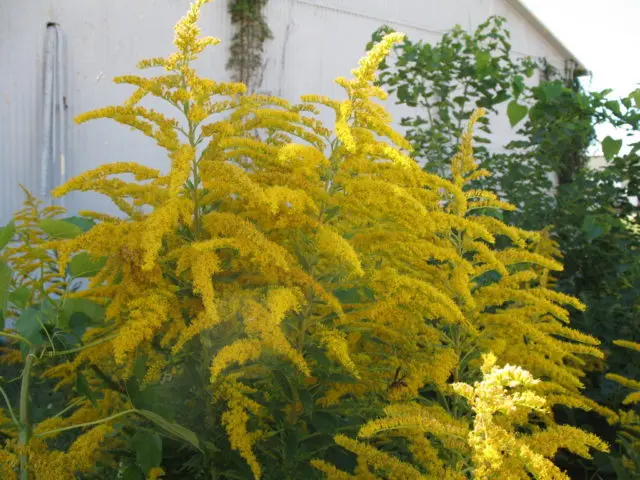
Reed flowers of the cultivar ‘Goljungle’ are underdeveloped
Pillar
The variety “Pillare” got its name for the shape of the bush in the form of a column. Its height is above average – about 90 cm. The shoots are strong, covered with a large amount of olive-colored foliage with small notches along the edges. The inflorescence is a narrow panicle 15 cm long, its width is 5 cm. They have the most tubular bright yellow flowers that appear on goldenrod bushes in the second decade of August.

Goldenrod ‘Pillar’ blooms for about 40 days
Goldtann
The late-flowering variety of the hybrid goldenrod Goldtann (Goldtanne) has a shoot height of up to 2 m. The leaves of the plant are narrow, with sharp ends, blue-green in color. Veins and small notches along the edges are clearly visible on them. The inflorescence in the form of a panicle is large (up to 50 cm in length), the flowers in it are densely arranged. They appear on the perennial in early September, gradually changing color from straw to amber yellow.
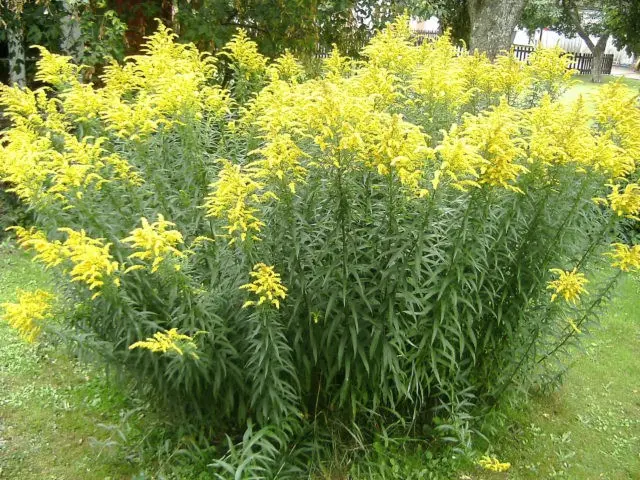
Peduncles solidago varieties “Goldtann” have high strength
Two color
The distribution area of the bicolor goldenrod is North America. The plant has a height of 120 cm. Its stems are stiff, pubescent, gray-green in color, covered with elliptical foliage with small teeth along the edges. A distinctive feature of the species is the two-color panicles. Baskets have both white and cream flowers.
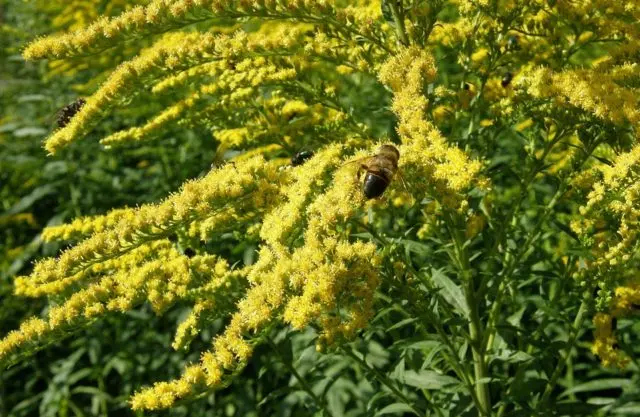
In a two-color solidago, the buds do not bloom at the ends of the shoots, but in the leaf axils
Wrinkly
Wrinkled goldenrod is a tall perennial, the length of its shoots is 80-120 cm. The unstable stems grow in the form of a bush. The flowers of the plant are collected in yellow panicles, which have a tart smell. The wrinkled look grows well both in the sun and in the shade, has a high winter hardiness.
Perennial grows rapidly, flowering begins in September and continues until winter.
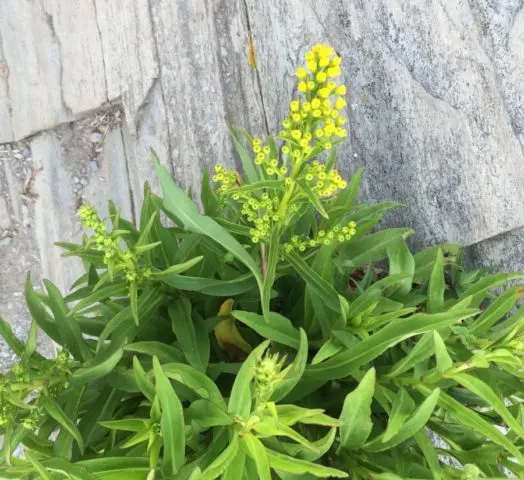
Wrinkled goldenrod develops rapidly on loam
bluish gray
The species is distributed in Canada and the USA. Its appearance is very different from other goldenrods. The bush looks elegant because of the bare long branches, the leaves of which are located only at the very top. They look like willow, jagged, emerald hue. The inflorescence brush is rare, outwardly resembles a necklace, blooms in late autumn and blooms until winter.
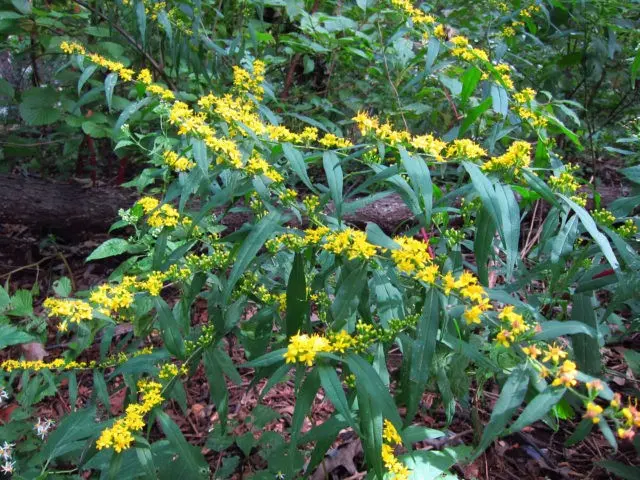
The stems of bluish-gray goldenrod can be 0,3 to 1,2 meters long.
Daursky
The birthplace of the Daurian goldenrod is Siberia. The bush is distinguished by the power of shoots that do not have branches, except in inflorescences. The upper part of the stems is covered with hairs, the lower part is bare. The foliage has different petioles – they are short at the top, long at the bottom. Plant height 1 m. Inflorescence of a simple form in the form of a panicle, composed of small yellow baskets.
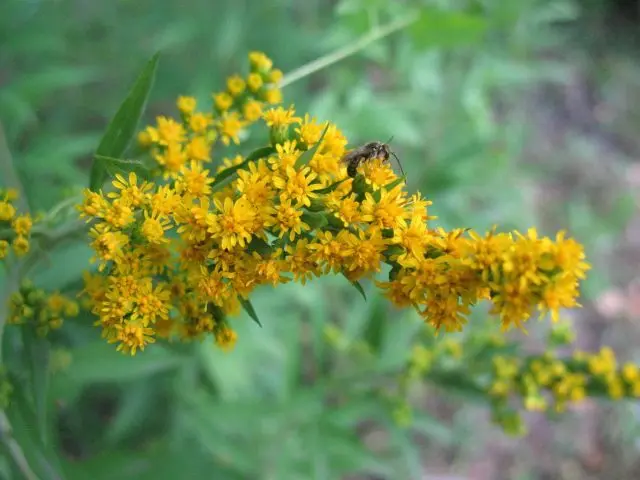
Goldenrod “Daursky” grows in woodlands, in the riverbeds of Central Siberia
Goldenrod in landscape design
Most varieties of solidago can be grown as ornamentals and used to create compositions that are as close to the natural look as possible. They are placed on a discount, flower bed, mixborder, used as a border or tapeworm.
Tall species are planted in the back of the site, creating a background for other plants from them, dwarf ones are placed in the foreground. Flowering of goldenrods can be extended for several months if you choose the right varieties.
Rudbeckia, echinacea, zinnia, dahlias and cereal plants look advantageous as neighbors next to solidago.
Methods of reproduction
To obtain new goldenrod seedlings, you can use one of the following methods:
- sowing in the ground;
- use of seedlings;
- division of the bush;
- cuttings.
The most popular method of dividing the bush, since it allows you to save the varietal qualities and characteristics of the goldenrod, the plant takes root well, blooms in the same year.
Planting and caring for goldenrod
With proper planting and proper care, solidago can grow in one place for up to 10 years. It is necessary to ensure that the plant does not get sick, does not become bare in the center of the bush, and take measures to eliminate the shortcomings – loosen, water and fertilize in time.
Terms and rules of landing
The placement of goldenrod in open ground can be carried out both in spring and in autumn.
To plant a perennial, you need to choose a sunny place for it or an area with a light shade, then dig up the soil and add humus or compost. Mineral fertilizers are added to the prepared wells and mixed with the soil. The roots of the plant are straightened in a pit, gently sprinkled and moistened abundantly.
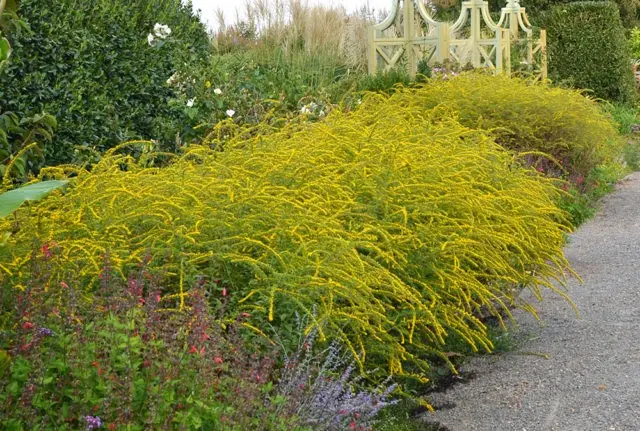
In China and Poland, goldenrod is classified as a quarantine plant.
Peculiarities of growing
The common goldenrod is unpretentious, planting and caring for it is not difficult. Even after minimal attention, it responds with abundant flowering, rapid growth and development.
By providing the plant with proper lighting, it is possible to achieve an increase in the size of the inflorescences, their greater brightness. At the same time, an overabundance of top dressing leads to a strong development of shoots at the expense of flowering. The poverty of the soil affects the growth of goldenrod – it develops more slowly and blooms less luxuriantly.
Watering and fertilizing schedule
The shrub does not need watering if it rains periodically. In hot, dry weather, goldenrod should be abundantly moistened once a week.
Feeding under the plant is required only in case of depletion of the soil. Organic and mineral fertilizers are applied twice a season – in spring and autumn.
Pruning and preparing for winter
Goldenrod does not require special preparation for winter, as it belongs to frost-resistant species. In late autumn, its shoots are cut to a height of 15 cm from the soil surface. In the spring, sanitary cleaning is carried out, removing weakened branches. The procedure allows you to achieve a powerful look and spectacular flowering of plants.
Diseases and pests
Despite the resistance of goldenrod to diseases, drought, thickening of plantings and an excess of nitrogen in the soil lead to damage to the plant by powdery mildew and rust. To combat pathologies, spraying with Bordeaux mixture and copper sulfate is used.
The most dangerous insects include lace bugs – small bugs that can destroy the plant, and caterpillars that twist the leaf plates, which leads to their drying out. The most effective means of pest control are insecticides.
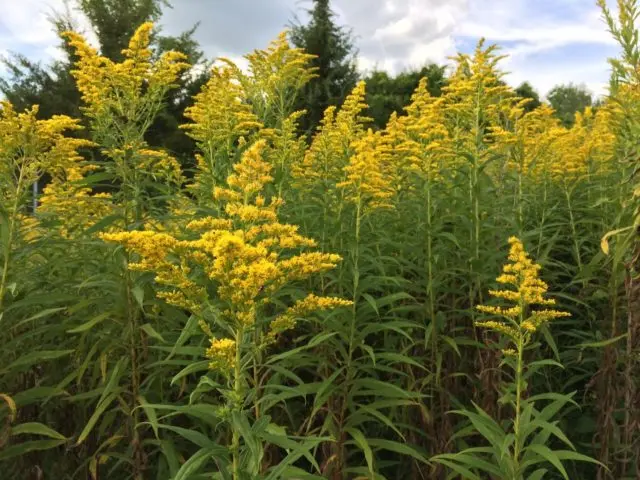
The goldenrod bush looks neat if you cut it regularly.
Goldenrod like a weed
Despite the fact that solidago is a good honey plant and a beautiful ornamental plant, it can be harmful to the environment. The perennial produces a huge amount of seeds that, after ripening, can scatter over long distances. Due to the high percentage of germination, it fills vast territories and displaces the usual field plants – clover, cornflowers, willow-herb, and even shrubs. Following the plants, insects, animals and birds disappear due to the loss of their food supply, because the goldenrod itself is unsuitable for food.
Capturing meadows, the perennial worsens the quality of pastures and hayfields, the soil becomes hard and dense. It is very difficult to fight it, only herbicides in high concentrations help, the use of which is limited near the residential area and water bodies. In some countries, the plant is included in the list of quarantine plants that pose a threat to biological diversity, human life and health. The fight against goldenrod is carried out at the state level.
How to get rid of goldenrod on the site
In order for solidago plantings not to turn into thickets, it is necessary to carry out preventive work:
- Mowing shoots immediately after flowering 2-3 times per season.
- Digging the soil around the bushes and removing overgrown roots.
- Mulching the soil with dense material under the plant.
Conclusion
Common goldenrod grows easily and quickly in any climate and soil. It is necessary to choose the right type of plant so that it looks decorative and at the same time does not harm the environment. With proper care, the perennial looks luxurious and decorates the site with its bright sunny color.









